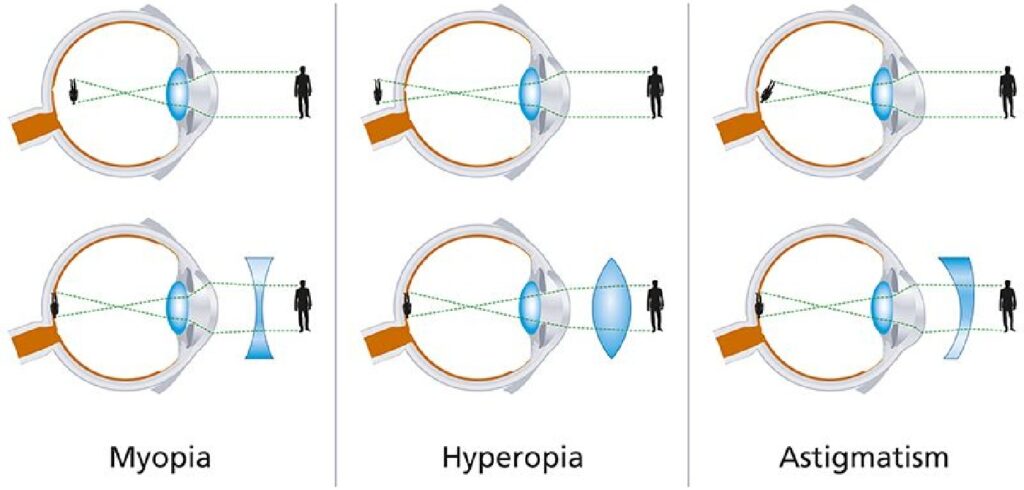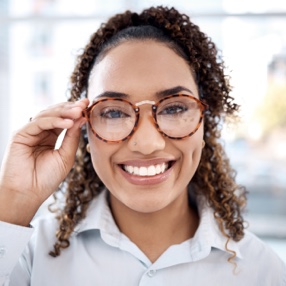Both are common vision problems, but they affect how you see in very different ways. Astigmatism causes blurry vision at all distances due to an irregularly shaped cornea or lens, while myopia—also known as nearsightedness—makes distant objects appear blurry because of the eye’s shape. Though often misunderstood, both conditions are treatable with modern eye care and regular monitoring. They may sometimes occur together, making understanding the distinction between the two important when it comes to managing your eye health effectively.
With the right diagnosis and treatment, you can enjoy clear, comfortable vision. Clarity Optometry & Vision Care is here to help you better understand your eyes and find the care that fits your needs.
Decoding Astigmatism
What Causes Astigmatism?
Astigmatism is a refractive error caused by an irregularly shaped cornea or, in some cases, the lens. Instead of being round like a basketball, these structures take on a more football-like shape, causing light to focus unevenly on the retina. The result? Blurred or distorted vision.
Astigmatism may be genetically inherited or can develop after an eye injury, surgery, or conditions like keratoconus. Contrary to what you might have heard, poor lighting or sitting too close to the TV won’t cause astigmatism.
Common Symptoms
Here are some common symptoms of astigmatism:
- Blurred or distorted vision, regardless of distance
- Eye discomfort or strain
- Frequent headaches, particularly after concentrative activities like reading or screen time
- Difficulty focusing on fine details
Many people don’t even realize they have astigmatism until an eye exam reveals it. Early detection is especially important for children, as untreated astigmatism can impact school performance and quality of life.
How is Astigmatism Treated?
Thankfully, in many cases, astigmatism is easily managed with a range of treatments, such as:
- Glasses or contact lenses: Special cylindrical lenses or toric contacts can help to correct uneven curvatures.
- Orthokeratology (Ortho-K): Rigid lenses worn while you sleep temporarily reshape the cornea for clearer daytime vision.
- Laser surgery: Procedures like LASIK or PRK can permanently reshape the cornea for clearer eyesight.
What is Myopia?
Understanding Nearsightedness
Myopia, also known as nearsightedness, occurs when the eyeball is too long or the curvature of the cornea is too steep. This causes light to focus in front of, rather than directly on, the retina. Distant objects look blurry, while close-up vision remains sharp and clear.
Why Does Myopia Happen?
Myopia often runs in families. Genetics play a significant role, but environmental factors like excessive screen use and limited outdoor activities can also contribute to its development, particularly in children. Cataracts and diabetes may also be a factor.
Symptoms of Myopia
- Blurred vision when viewing distant objects (like a classroom board or road signs)
- Squinting to see more clearly
- Eye strain or headaches
- Difficulty seeing in low light
- Kids may sit close to the TV or hold books very near to their face

Correcting Nearsightedness
Several options can help manage or correct myopia:
- Prescription glasses or contacts: Standard lenses redirect light to focus on the retina, offering clear distance vision.
- Myopia management programs: These may include DIMS lenses, ortho-k lenses, specialized contact lenses, or atropine eye drops to slow progression in children.
- Laser surgery: LASIK and similar surgeries can correct myopia by reshaping the cornea.
Myopia Control Options
For families concerned about the progression of nearsightedness, Clarity Optometry & Vision Care offers clinically proven treatments that help slow myopia in children.
We provide daily disposable contact lenses such as MiSight 1 Day by CooperVision and Abiliti by Johnson & Johnson. These lenses correct blurry vision with a unique optical design that helps reduce myopia progression over time.
We also provide specially designed optical DIMS lenses such as Hoya MiyoSmart or Riverside MyoPersona. These lenses create a peripheral defocus while maintaining clear, central vision.
These options not only correct vision but also support long-term eye health by minimizing ocular disease such as cataract, glaucoma, and myopic maculopathy
Astigmatism vs. Myopia
Both astigmatism and myopia are refractive errors, but they differ in the way they affect vision:
- Distance vs. distortion: Myopia makes distant objects blurry while astigmatism causes blurred or distorted vision at all distances.
- Causes: Myopia stems from the eyeball’s length or corneal curvature, whereas astigmatism is due to irregularities in the shape of the cornea or lens.
- Treatment approach: While glasses, contacts, and surgery treat both issues, astigmatism often requires specialized lenses like toric contacts.
It’s worth noting that both conditions can occur together, as one doesn’t rule out the other.

Tips for Maintaining Healthy Vision
Whether you have perfect eyesight or need corrective lenses, taking care of your eyes is a priority:
- Spend more time outdoors, especially for children (it may help reduce the risk of developing myopia).
- Follow the 20-20-20 rule during screen time (look at something 20 feet away for 20 seconds every 20 minutes).
- Make eye exams a priority, even if your vision seems fine.
- Wear sunglasses with UV protection. Prolonged sun exposure can damage your eyes and increase the risk of cataracts and other conditions. Choose sunglasses that block 100% of UVA and UVB rays.
- Eat a balanced diet rich in eye-healthy nutrients. Foods like leafy greens, carrots, sweet potatoes, and fish high in omega-3s can support eye health and reduce the risk of age-related vision issues.
We’re Here to Support Your Vision
Managing conditions like astigmatism or myopia is simple with the right care and expertise. At Clarity Optometry & Vision Care, we focus on personalized solutions tailored to your needs.
Whether you’re a student juggling studies or a parent helping your child see the board clearly, we’re here to guide you every step of the way. Book an appointment today and discover how better vision can transform your life.

























